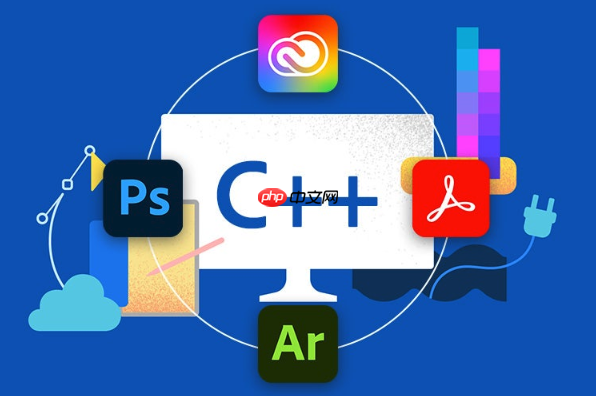RAII通过将资源生命周期与对象绑定,在构造时获取资源、析构时释放,确保异常安全和自动清理。C++中智能指针(如std::unique_ptr、std::shared_ptr)、std::lock_guard、std::fstream等标准库工具是RAII的典型应用,同时可自定义RAII类或使用unique_ptr配合自定义删除器管理非标准资源,提升代码安全性与简洁性。

C++中,RAII(Resource Acquisition Is Initialization,资源获取即初始化)是一种核心的编程范式,它通过将资源的生命周期与对象的生命周期绑定,确保资源在不再需要时能被自动、安全地释放,极大地简化了错误处理和资源管理,有效避免了内存泄漏和资源泄漏。
RAII的本质在于,当一个对象被创建时,它会获取所需的资源(例如内存、文件句柄、互斥锁等),并在对象生命周期结束时(无论是正常退出作用域还是通过异常退出),其析构函数会自动释放这些资源。这种机制让资源管理变得几乎“无感”,开发者可以更专注于业务逻辑,而不用时刻担心资源的清理问题。
实践中,我们主要通过以下方式应用RAII:
std::unique_ptr
std::shared_ptr
std::lock_guard
std::scoped_lock
std::fstream
说RAII是C++现代编程的基石,这绝不是夸大其词。我个人觉得,它解决的痛点太核心了。你想想看,在没有RAII的时代,或者在C语言那种需要手动管理资源的语境下,一个函数里如果涉及多次资源分配(比如
malloc
fopen
pthread_mutex_lock
goto
if
立即学习“C++免费学习笔记(深入)”;
RAII彻底改变了这种局面。它把资源管理这个“脏活累活”封装进了对象的生命周期里。当对象被创建,资源就“顺带”被获取了;当对象超出作用域,无论是因为正常执行完毕,还是因为某个地方抛了异常,析构函数都会被调用,资源也就自然而然地被释放了。这带来的好处是多方面的:
所以,对我来说,RAII不仅仅是一个编程技巧,它更是一种思维模式,是C++“零开销抽象”哲学的一个完美体现。它让我们可以用更高级、更安全的方式来处理底层资源,同时几乎不引入额外的运行时开销。
标准库里,有几个明星成员,它们简直就是RAII的教科书式范例,用得好能让你的C++代码安全性和健壮性提升好几个档次。
首先,也是最重要的,是智能指针家族:
std::unique_ptr
unique_ptr
unique_ptr
delete
#include <memory>
#include <iostream>
#include <vector>
void processData(std::vector<int>* rawPtr) {
if (!rawPtr) return;
std::cout << "Processing data from raw pointer. Size: " << rawPtr->size() << std::endl;
// 假设这里可能抛出异常
}
void exampleUniquePtr() {
std::cout << "--- std::unique_ptr Example ---" << std::endl;
// 动态分配一个vector
std::unique_ptr<std::vector<int>> vecPtr = std::make_unique<std::vector<int>>();
vecPtr->push_back(10);
vecPtr->push_back(20);
std::cout << "Vector size (before move): " << vecPtr->size() << std::endl;
// unique_ptr 不能复制,只能移动
std::unique_ptr<std::vector<int>> anotherVecPtr = std::move(vecPtr);
// 此时 vecPtr 已经为空,所有权转移给了 anotherVecPtr
if (vecPtr == nullptr) {
std::cout << "vecPtr is now null after move." << std::endl;
}
// 使用另一个指针进行操作
std::cout << "Vector size (after move, via anotherVecPtr): " << anotherVecPtr->size() << std::endl;
// 也可以获取裸指针进行某些兼容C API的操作,但要小心
// processData(anotherVecPtr.get());
// 当 anotherVecPtr 超出作用域,它指向的vector会自动被delete
std::cout << "anotherVecPtr will be destroyed, memory released." << std::endl;
}std::shared_ptr
shared_ptr
shared_ptr
shared_ptr
#include <memory>
#include <iostream>
class MyResource {
public:
MyResource(int id) : id_(id) {
std::cout << "MyResource " << id_ << " acquired." << std::endl;
}
~MyResource() {
std::cout << "MyResource " << id_ << " released." << std::endl;
}
void doSomething() {
std::cout << "MyResource " << id_ << " doing something." << std::endl;
}
private:
int id_;
};
void passSharedPtr(std::shared_ptr<MyResource> res) {
std::cout << "Inside passSharedPtr. Use count: " << res.use_count() << std::endl;
res->doSomething();
} // res 离开作用域,引用计数减1
void exampleSharedPtr() {
std::cout << "\n--- std::shared_ptr Example ---" << std::endl;
std::shared_ptr<MyResource> ptr1 = std::make_shared<MyResource>(1);
std::cout << "ptr1 created. Use count: " << ptr1.use_count() << std::endl;
{
std::shared_ptr<MyResource> ptr2 = ptr1; // 复制,引用计数增加
std::cout << "ptr2 created. Use count: " << ptr1.use_count() << std::endl;
passSharedPtr(ptr2); // 传递副本,引用计数再次增加,函数结束后减回
std::cout << "After passSharedPtr. Use count: " << ptr1.use_count() << std::endl;
} // ptr2 离开作用域,引用计数减1
std::cout << "After ptr2 destroyed. Use count: " << ptr1.use_count() << std::endl;
// ptr1 离开作用域,引用计数减1,降为0,MyResource被释放
std::cout << "ptr1 will be destroyed." << std::endl;
}除了智能指针,还有互斥锁的RAII包装器:
std::lock_guard
std::scoped_lock
std::mutex
std::scoped_lock
#include <mutex>
#include <thread>
#include <iostream>
#include <vector>
std::mutex mtx;
int shared_data = 0;
void increment_data_safe() {
std::cout << std::this_thread::get_id() << ": Trying to acquire lock..." << std::endl;
// lock_guard 在构造时锁定 mtx,在离开作用域时解锁
std::lock_guard<std::mutex> lock(mtx);
std::cout << std::this_thread::get_id() << ": Lock acquired. Incrementing data." << std::endl;
shared_data++;
// 模拟一些可能抛异常的操作
if (shared_data % 3 == 0) {
// throw std::runtime_error("Simulated error!"); // 即使抛异常,锁也会被释放
}
std::cout << std::this_thread::get_id() << ": Data incremented to " << shared_data << ". Releasing lock." << std::endl;
} // lock_guard 离开作用域,mtx 自动解锁
void exampleLockGuard() {
std::cout << "\n--- std::lock_guard Example ---" << std::endl;
std::vector<std::thread> threads;
for (int i = 0; i < 5; ++i) {
threads.emplace_back(increment_data_safe);
}
for (auto& t : threads) {
t.join();
}
std::cout << "Final shared_data: " << shared_data << std::endl;
}这些工具都是RAII的典范,它们将复杂的资源管理逻辑隐藏在简单、安全的接口之下,让C++开发者能够编写出更健壮、更易于维护的代码。
有时候,标准库的智能指针或包装器可能无法直接满足我们对某些特定资源的管理需求。比如,你可能在和C语言库交互,获取的是原始的文件描述符、某个硬件设备的句柄,或者是一个数据库连接,这些都不是简单的
new/delete
核心原则很简单:构造函数获取资源,析构函数释放资源。 但实际操作起来,还有一些细节需要注意,特别是C++11之后的“五法则”(或“零法则”)。
让我们以一个简单的C风格文件句柄为例:
#include <cstdio> // For FILE*, fopen, fclose
#include <iostream>
#include <stdexcept> // For std::runtime_error
#include <utility> // For std::move
// 自定义一个FileHandle RAII类
class FileHandle {
public:
// 构造函数:获取资源
explicit FileHandle(const char* filename, const char* mode)
: file_ptr_(std::fopen(filename, mode)) {
if (!file_ptr_) {
throw std::runtime_error("Failed to open file: " + std::string(filename));
}
std::cout << "File '" << filename << "' opened." << std::endl;
}
// 析构函数:释放资源
~FileHandle() {
if (file_ptr_) {
std::fclose(file_ptr_);
std::cout << "File closed." << std::endl;
}
}
// 禁止拷贝构造和拷贝赋值,因为文件句柄通常是独占的
FileHandle(const FileHandle&) = delete;
FileHandle& operator=(const FileHandle&) = delete;
// 移动构造函数:转移所有权
FileHandle(FileHandle&& other) noexcept
: file_ptr_(other.file_ptr_) {
other.file_ptr_ = nullptr; // 源对象不再拥有资源
std::cout << "FileHandle moved." << std::endl;
}
// 移动赋值运算符:转移所有权
FileHandle& operator=(FileHandle&& other) noexcept {
if (this != &other) { // 避免自我赋值
if (file_ptr_) { // 如果当前对象持有资源,先释放
std::fclose(file_ptr_);
std::cout << "Current file closed before move assignment." << std::endl;
}
file_ptr_ = other.file_ptr_;
other.file_ptr_ = nullptr;
std::cout << "FileHandle move assigned." << std::endl;
}
return *this;
}
// 提供一个方法来访问底层资源,但要小心使用
FILE* get() const {
return file_ptr_;
}
// 提供一个操作资源的示例
void write(const std::string& data) {
if (file_ptr_) {
std::fprintf(file_ptr_, "%s", data.c_str());
std::fflush(file_ptr_); // 确保写入
}
}
private:
FILE* file_ptr_;
};
void exampleCustomRAII() {
std::cout << "\n--- Custom RAII FileHandle Example ---" << std::endl;
try {
// 创建一个FileHandle对象
FileHandle myFile("test.txt", "w+");
myFile.write("Hello, RAII!\n");
// 演示移动语义
FileHandle anotherFile = std::move(myFile); // myFile现在为空
anotherFile.write("This was moved.\n");
// 即使这里抛出异常,anotherFile也会在栈展开时被正确关闭
// throw std::runtime_error("Simulated error after writing.");
} catch (const std::runtime_error& e) {
std::cerr << "Error: " << e.what() << std::endl;
}
std::cout << "End of custom RAII example. File 'test.txt' should be closed." << std::endl;
}关键点和思考:
fopen
fclose
fopen
FILE*
= delete
nullptr
get()
get()
get()
noexcept
noexcept
std::terminate
fclose
更灵活的方式:使用std::unique_ptr
很多时候,你甚至不需要完全自定义一个RAII类。对于那些只需要在对象销毁时执行特定清理函数的资源,
std::unique_ptr
#include <memory>
#include <cstdio>
#include <iostream>
#include <functional> // For std::function
void exampleUniquePtrCustomDeleter() {
std::cout << "\n--- std::unique_ptr with Custom Deleter Example ---" << std::endl;
// 定义一个文件关闭器 lambda
auto file_closer = [](FILE* fp) {
if (fp) {
std::fclose(fp);
std::cout << "File closed by custom deleter." << std::endl;
}
};
// 使用 std::unique_ptr 和自定义删除器管理 FILE*
// unique_ptr<FILE*, decltype(file_closer)> file_ptr(std::fopen("log.txt", "w"), file_closer);
// 或者用 std::function 包装
std::unique_ptr<FILE, std::function<void(FILE*)>> log_file(
std::fopen("log.txt", "w"),
[](FILE* fp) {
if (fp) {
std::fclose(fp);
std::cout << "Log file closed by std::function deleter." << std::endl;
}
}
);
if (log_file) {
std::fprintf(log_file.get(), "This is a log entry.\n");
std::fflush(log_file.get());
std::cout << "Wrote to log.txt" << std::endl;
} else {
std::cerr << "Failed to open log.txt" << std::endl;
}
// 当 log_file 超出作用域,lambda deleter 会被调用,关闭文件
std::cout << "End of unique_ptr custom deleter example." << std::endl;
}这种方式的优点是,你不需要编写一个完整的类,只需要提供一个清理函数。它利用了
unique_ptr
总的来说,无论是自定义RAII类还是利用
unique_ptr
以上就是C++如何使用RAII管理资源和内存的详细内容,更多请关注php中文网其它相关文章!

每个人都需要一台速度更快、更稳定的 PC。随着时间的推移,垃圾文件、旧注册表数据和不必要的后台进程会占用资源并降低性能。幸运的是,许多工具可以让 Windows 保持平稳运行。

Copyright 2014-2025 https://www.php.cn/ All Rights Reserved | php.cn | 湘ICP备2023035733号